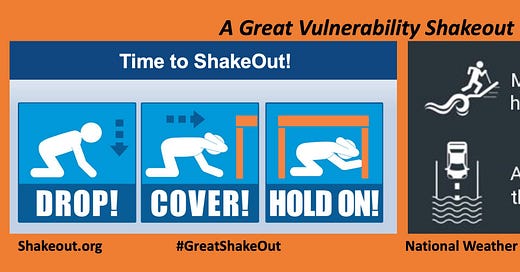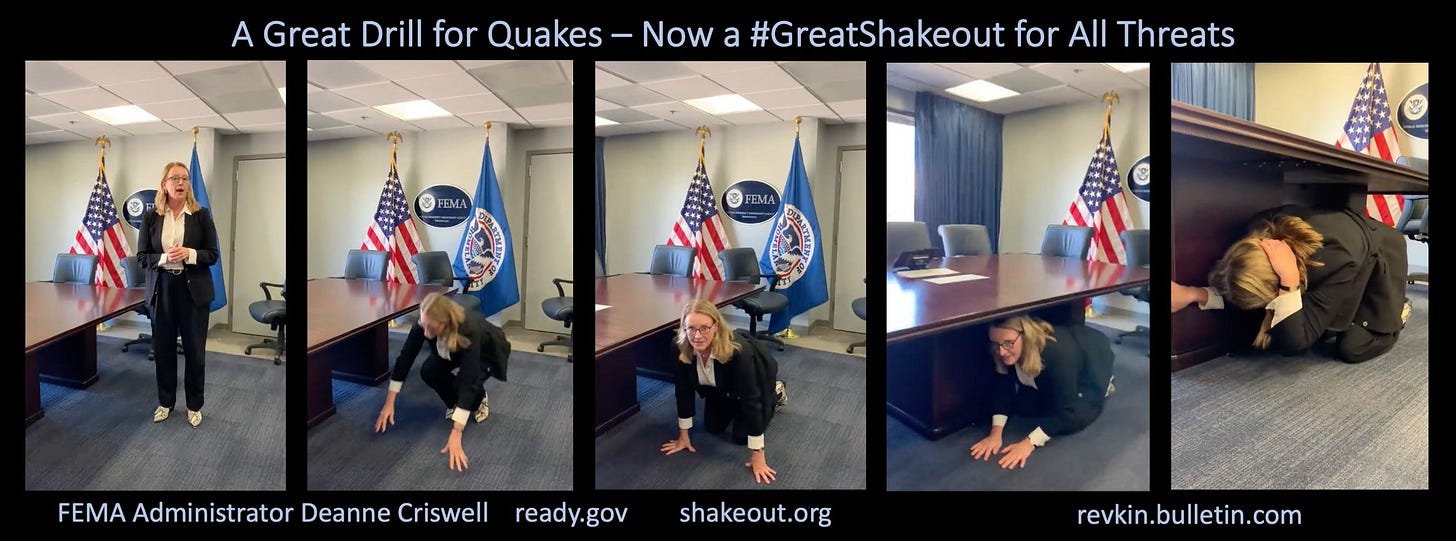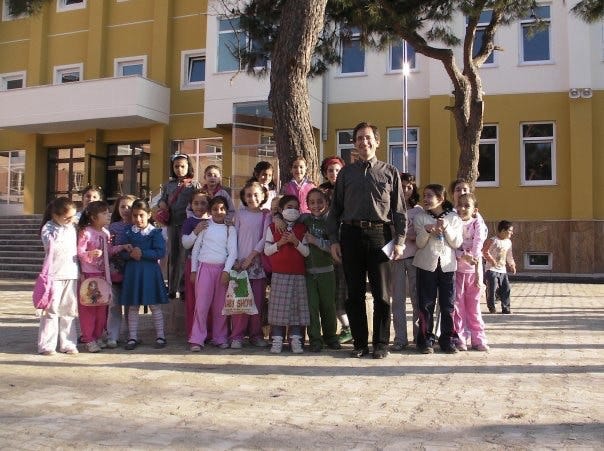As Extreme Storms Strike Again, It's Time to Shake out Community Climate Vulnerabilities
An annual #GreatShakeout drill in earthquake country can be a model for communities to spot and cut vulnerability to floods, heat and other climate hazards.
🌧️ Please subscribe (free of charge) to this Sustain What newsletter - my journalistic journey building a cooler relationship between people, our planet and each other, one post at a time. ⛈️ One core theme is identifying steps that cut societal risk when the worst happens - whether the hazard is in the air, water or under our feet.
Disasters are Societal, not Climatological
As veteran disaster scientists have long noted, societal factors are the prime determinant of disaster losses - not the hazard itself. This tweet on the “pressure model” says it all. That means, with or without global warming, there are urgent opportunities to cut vulnerability in every community on Earth.


I've been covering earthquakes, sadly, for more than 20 years, about a decade less than my reporting history on climate change and extreme weather, but long enough to see a similar pattern emerge in human responses to these environmental threats.
That pattern was distilled by a reader of my New York Times Dot Earth blog long ago as "blah, blah, blah, BANG."
Overall, deaths in all disasters have declined steadily. But way too many lives are lost avoidably each year.
No Natural Disasters
Remember, it is almost always human inaction that turns an impact of a natural hazard into an unnatural disaster.
This post is about what can be done locally to cut the toll.
I think we can build on the best of the Great Shakeout earthquake drill that takes place on the third Thursday of every October and National Preparedness Month (each September), which the Federal Emergency Management Agency and partners use to boost responsiveness to all kinds of threats.
One of my favorite disaster-risk experts, Ilan Kelman, the author of Disaster by Choice, said what's really needed is a great vulnerability shakeout.
Let's explore what that can look like.
Given this fall's wild meteorological ride, with West Coast drought-to-flood weather whiplash and an extreme fall East Coast nor'easter, there's no time like the present to widen the work. And it's a good time to recall the dozens who perished avoidably in submerged basements and cars as the remains of Hurricane Ida swept the Northeast in September. We can do so much better.
A "shakeout" success story
To boost personal safety in earthquakes, the annual Great Shakeout readiness drill has grown into a worldwide phenomenon in areas prone to frequent quakes or those, like the Pacific Northwest and central United States, where rare but potent temblors have caused, and will cause, terrible havoc.
This year, some 30 million people in dozens of countries and across the United States participated in drills organized through companies, schools, agencies or other institutions - all centering on the "drop, cover and hold on" exercise.
Here's one variant I witnessed at a school in the quake-threatened megacity of Istanbul in 2009. Read my 2010 Times story on megacities and quake risk.
In recent months, seeing so many instances where a bit more awareness and responsiveness to extreme weather could have saved lives, I'd made the case (on Twitter and my webcasts) for expanding the shakeout model beyond quake readiness to a general "risk shakeout" - taking a day not only to rehearse your personal response to warnings (like highway signs flashing "turn around, don't drown"!) but also pausing to gauge and cut vulnerabilities facing the most vulnerable people around you - all too often people marginalized by poverty or race.
I had a great Columbia Climate School Sustain What discussion about this last week with Deanne Criswell, the new administrator of the Federal Emergency Management Agency. We were also joined by Samantha L. Montano, an emergency management expert and author of Disasterology, and Jeff Schlegelmilch, the director of Columbia's National Center on Disaster Preparedness and author of Rethinking Readiness.
I spoke with Criswell on, yes, Great Shakeout Day, when she demonstrated the drop, cover and hold method on Twitter. I hope you'll watch and share our discussion on Facebook, LinkedIn, Twitter and YouTube.
Criswell, who worked in front-line positions at FEMA and the National Guard before taking on her leadership role, said that a growing priority at the agency is to empower local communities through risk mitigation grants and other work so that vulnerability is reduced and responsiveness boosted ahead of time.
"Where I want to focus is on how we help communities right down to the neighborhood level actually work together and know how they're going to support each other," Criswell said. "We had a great community when I worked in Aurora, Colorado, called Heritage Eagle Bend. It was a 55-and-older community. They developed their own emergency management team. They had the list of the neighbors that were very vulnerable. When something happened, they would call them, they would check on them, and they had teams that were designed to go check on neighbors. Such a great example of how neighbors helping neighbors can make such a big difference."
It's vital to spread such models and success stories. (On Facebook you can watch a CPR training exercise put on by that Heritage Eagle Bend group.)
Help me here: What's going on where you live that is boosting resilience and cutting vulnerability where the need is greatest? Please weigh in below.
An urgent need: disaster justice
Samantha Montano, who teaches at Massachusetts Maritime Academy, proposed that as more and more communities experience disasters in our changing climate there may finally be the prospect of a "disaster justice" movement helping prompt more engagement from local elected officials.
Jeff Schlegelmilch, my Columbia colleague, said true disaster justice has to include helping communities with the greatest need get the resources required to move from good intentions to impact. There are substantial hurdles, including tangled bureaucracies.
He said it's great that FEMA has released several billion dollars in new community-focused hazard mitigation grants. But there's an accessibility divide. "I know one of FEMA's pillars of their strategic plan is to simplify FEMA," Schegelmilch said. "But I don't know how much of that is actually doable by FEMA and how much actually has to come in the legislation. So I'm all for legislating more money, but we also need to legislate easier ways to access that money. Otherwise only those who can afford lawyers and professional grant writers."
Community climate action
Whether the hazard is an earthquake, a flood, a tornado or, yes, a pandemic, one common reality is that the scope of risk posed to a community is almost always dependent on the mix of vulnerability and readiness of people and critical systems in harm's way.
Haiti and Chile had profoundly different death tolls in similar powerful earthquakes in 2010.
Deaths in Oregon in this year's epic Pacific Northwest heat dome were concentrated in populations with high vulnerability - like elderly residents of mobile homes without air conditioning.
The New York University sociologist and writer Eric Klinenberg, who did a landmark study and book on the great 1995 Chicago heat wave, said this when I queried him after the devastating New York-area flash flood losses:
"The key to helping neighborhoods do better in crises is to help them be safer, healthier, and better connected every day. Why do people drown when NYC floods? Because they live in apartments below grade. Why do people die of heat waves? Because they are socially isolated, old, sick, and invisible. Perhaps that's why deeply entrenched, well run, highly-local community organizations prove most effective in disasters. They know who's at risk, who can help, and how to get things done. They are trusted. I think it would be hard for a climate group to do that kind of daily work. But now maybe we will have enough disasters that I'm wrong."
For more, read his 2012 New Yorker story, "Adaptation - How cities be 'climate-proofed'?"
I'm convinced a climate vulnerability shakeout - a day to convene and test and look outward - can make a difference.
I sought ideas and examples from Raj Pandya, who runs the American Geophysical Union's Thriving Earth Exchange, which connects communities at risk with relevant expertise. He pointed me to the work of Daniel Homsey of Neighborhood Empowerment Network on San Francisco, which initiates community-led resilience conversations and helps them move from motivation to action with a host of tools and connections.
Please watch this "Prep Talk" that Homesey gave for FEMA on "Neighborfests - Building Resilience from the Block Up!”
This model simply must spread beyond San Francisco!
Over and over, from Bangladesh to Chicago to Istanbul, the core characteristics that boost a community's capacity for risk reduction before the flood, fire or deadly heat strike are awareness of local social vulnerabilities; awareness of the extent of hazards through links to relevant data (like New York City's new Stormwater Flood Map), and understanding of how to respond to a warning
Much work needs to be done on all of these fronts, at every scale - including in climate diplomacy.
Community vulnerability and COP-26?
At the COP-26 climate treaty talks starting in Glasgow this weekend, I know Saleemul Huq from the International Center for Climate Change Adaptation and others will be making the case for some of the funding pledged by rich countries for resilience building in poor ones to go to community-based work.
I hope they're heard above the din around emission pledges.
Reducing heat-trapping pollution is vital for cutting climate risk on long time scales but does nothing to curtail vulnerability to dangers on the ground today.
Deeper dive
Here are several recent relevant Sustain What events:
Journalists and Scientists Dig in on Vulnerability to Extreme Heat
After Ida - Paths to Flash Flood Safety
The Vulnerability Crisis that Hides Behind the Climate Crisis
Read Eric Sanderson's fantastic New York Times op-ed article: Let Water Go Where It Wants to Go
Help expand Sustain What
Any new column needs the help of existing readers. Tell friends what I'm up to by sending an email here.
I hope you'll subscribe here and weigh in with a comment or question. I plan to keep content free for all while eventually offering fans a way to support this project financially.
Send feedback (including concerns or corrections!), tips, ideas here.
Find my social media accounts, books and music in a single click here.
~~~
As a parting shot, here are some of the children I met in Istanbul back in 2009 while reporting not only on the megacity's earthquake threat, but also on a wonderful community-training project helping neighborhoods across the city prepare for the worst. That's what this is all about.









